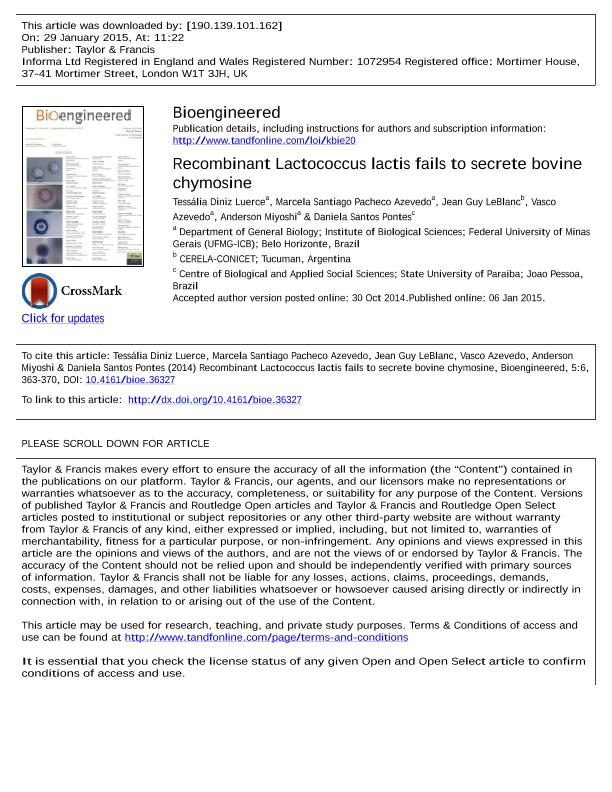Artículo
Recombinant lactococcus lactis fails to secrete bovine chymosine
Diniz Luerce, Tessália; Santiago Pacheco Azevedo, Marcela; Leblanc, Jean Guy Joseph ; Azevedo, Vasco; Miyoshi, Anderson; Santos Pontes, Daniela
; Azevedo, Vasco; Miyoshi, Anderson; Santos Pontes, Daniela
 ; Azevedo, Vasco; Miyoshi, Anderson; Santos Pontes, Daniela
; Azevedo, Vasco; Miyoshi, Anderson; Santos Pontes, Daniela
Fecha de publicación:
11/2014
Editorial:
Taylor & Francis
Revista:
Bioengineered
ISSN:
2165-5979
e-ISSN:
2165-5987
Idioma:
Inglés
Tipo de recurso:
Artículo publicado
Clasificación temática:
Resumen
Bovine chymosin is an important milk-clotting agent used in the manufacturing of cheeses. Currently, the production of recombinant proteins by genetically modified organisms is widespread, leading to greatly reduced costs. Lactococcus (L.) lactis, the model lactic acid bacterium, was considered a good candidate for heterologous chymosin production for the following reasons: (1) it is considered to be a GRAS (generally regarded as safe) microorganism, (2) only one protease is present on its surface, (3) it can secrete proteins of different sizes, and (4) it allows for the direct production of protein in fermented food products. Thus, three genetically modified L. lactis strains were constructed to produce and target the three different forms of bovine chymosin, prochymosin B, chymosin A and chymosin B to the extracellular medium. Although all three proteins were stably produced in L. lactis, none of the forms were detected in the extracellular medium or showed clotting activity in milk. Our hypothesis is that this secretion deficiency and lack of clotting activity can be explained by the recombinant protein being attached to the cell envelope. Thus, the development of other strategies is necessary to achieve both production and targeting of chymosin in L. lactis, which could facilitate the downstream processing and recovery of this industrially important protein.
Archivos asociados
Licencia
Identificadores
Colecciones
Articulos(CERELA)
Articulos de CENTRO DE REFERENCIA PARA LACTOBACILOS (I)
Articulos de CENTRO DE REFERENCIA PARA LACTOBACILOS (I)
Citación
Diniz Luerce, Tessália; Santiago Pacheco Azevedo, Marcela; Leblanc, Jean Guy Joseph; Azevedo, Vasco; Miyoshi, Anderson; et al.; Recombinant lactococcus lactis fails to secrete bovine chymosine; Taylor & Francis; Bioengineered; 5; 6; 11-2014; 363-370
Compartir
Altmétricas



